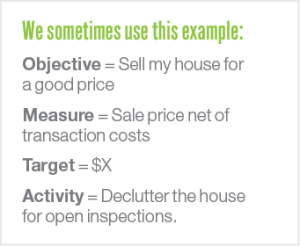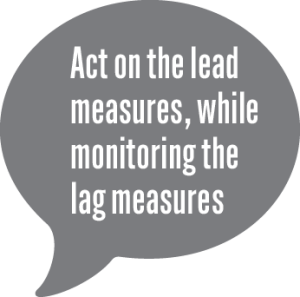Setting strategic measures – four suggestions to make it worth the effort
by Dr Marc Levy
Right Thinking
Selecting strategic measures is a subtle process that warrants careful deliberation. Although the task of setting strategic measures may appear straightforward, it can be treacherous and we encounter poorly defined measurement systems all too frequently.
We encourage our clients to begin the process by creating a ‘house theory of measurement’ in which they identify the desirable properties of their strategic measures. This process compels leaders to think deeply about measurement and helps them select measures that are tailored to the needs of their organisations.

Managers often find measurement tricky, more than, say, generating options, setting objectives, prioritising initiatives or many of the other endeavours of strategy and planning.
There are good reasons for this: defining measures of success can be painstaking, technical work and, let’s be honest, for some, it can be a little tedious.
Consequently, when doing strategic reviews or working with clients on strategic plans we find problems with their legacy measurement systems – the measures are not well defined; the measures are not measures but objectives, activities or deliverables; there are no targets set for the measures, or targets are set but without reference to baseline data; some of the measures are gauging something important and others are not; data for the measures is collected over widely divergent time horizons; top level measures are not properly cascaded to teams; or there is scant attention paid to performance monitoring.

We also encounter confusion about the language of the discipline – KRAs, KPIs, measures, metrics, targets and so forth. I’m going to side-step these definitional problems (to focus on what’s more important) by suggesting a simple framework: objectives reflect what an organisation is trying to achieve; and organisations set measures and corresponding targets to determine whether these objectives are being met. What the organisation chooses to do (let’s call them activities) should propel it towards achievement of the targets.
1. A good place to start is to create your own theory of measurement
Before we craft measures with clients, we often help them to create a ‘house theory of measurement’.
This can be a more interesting conversation for a senior team than the measures definition and target setting that follows it. The house theory is usually comprised of a list of principles like the following, which are an amalgam of real client examples:
- Measures must be clearly defined – measure description and formula, frequency of data collection, data source, unit type, etc.
- We will only employ measures for which we can source high quality, timely data
- A good result on the measure will have a material impact on the performance of the business
- We should have fewer than ten measures relating to achievement of our strategy
- Wherever possible our measures will be quantifiable e.g. a number or rating
- We will try to ensure that there are no problematic unintended consequences from the measures we select (at least none that can’t be mitigated by complementary measures).
2. Lead and lag measures

We encourage clients to first choose measures that are as far along the ‘input – outcome’ continuum as they can go. Not the number of customer complaints nor customer dissatisfaction, but perhaps the defection that may come from that dissatisfaction or, better still, the value lost by dint of customer churn.
This process of pushing towards outcomes naturally leads to lag measures that need to be complemented by lead measures. Lead measures seek to predict the outcome and timely data relating to them is ideally more freely available.
Teams can keep an eye on lead measures, and try to shift them if necessary, in order that the relevant outcome remains on track. Common sales pipeline measures illustrate this approach. In a business to business context, a lead measure might be the number of new business proposals over a certain value to target customers. This may predict a sales outcome – or lag measure – like new revenue ($m) from priority customers. Franklin Covey produces simple, instructive video content on the complementarity of lead and lag measures encouraging managers to act on the lead measures, while monitoring the lag measures (Covey 2016)
3. Set measures as distinct from activities or deliverables
Measures aren’t the same as activities or deliverables. Activities and deliverables often have binary, yes/no possibilities: did someone get something done by the due date or not. On the other hand, you can normally put a number next to a measure. This sounds pernickety, but we’ve found that strategic plans are more intuitive, easier to implement, and more straightforward to monitor and review, when planners are consistent about what is measuring success and what is
driving it.
4. Qualitative measurement has a place
We’ve sometimes been dogmatic about the primacy of quantitative measurement: crafting measures for which the corresponding targets must be expressed as absolute numbers, relative numbers, proportions or ratios can bring clarity to an arcane pursuit. But qualitative measurement can be useful, as we have learnt in measuring the social impact of our own work. As Jim Collins observed in his excellent monograph, Good to great and the social sectors (2005):
‘It doesn’t really matter whether you can quantify the results. What matters is that you can rigorously assemble evidence – quantitative and qualitative – to track your progress. If the evidence is primarily qualitative, think like a trial lawyer assembling a combined body
of evidence.’
***
To paraphrase Lenin, a strategy without measurement is blind; measurement that is not anchored to strategy is arbitrary. Thoughtful measurement is integral to strategy and planning. Through measurement we specify the impacts we want to have; we work out whether we are having the intended impacts; and we adjust course if things aren’t working out as we planned. While measurement can be taxing for executive teams and boards, we’ve found that following these simple suggestions can make measurement simpler and less confounding.
References
Collins, J 2005, Good to great and the social sectors, Elements Design Group, California.
Covey, S 2018, 4 Disciplines of Execution, viewed 14 June 2016, <https://www.franklincovey.com/the-4-disciplines/discipline-2-act.html>
For more information contact Marc Levy on marc@rightlane.com.au
© 2018 Right Lane Consulting
